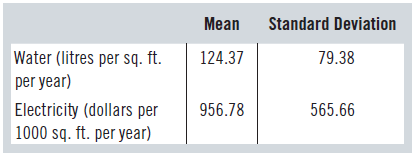A major Canadian retailer with stores only in large cities includes food items in some stores but
Question:
A major Canadian retailer with stores only in large cities includes food items in some stores but not in others. Selling food requires refrigeration equipment, which considerably increases the electricity bill. It also increases water usage for washing fresh food. The retailer is investigating ways of reducing water and electricity usage, to reduce both operating costs and its environmental footprint. It wants to identify stores that have particularly low water and electricity usage as examples of what other stores might achieve and obtains two histograms:

The mean and standard deviations are:

a) Using z-scores, compare the following stores:

b) Describe the shapes of the histograms and the format in which they are drawn. What might the shapes imply? What should be the next step in analyzing this data? (You are not asked to perform this next step, just to say what it is.)
c) In order to select stores that have low water and electricity usage as an example to other stores, the company instructs its statisticians to select stores toward the left end of the two histograms. Comment on the ethics of this instruction using the ethical guidelines in Appendix C.
Step by Step Answer:

Business Statistics
ISBN: 9780133899122
3rd Canadian Edition
Authors: Norean D. Sharpe, Richard D. De Veaux, Paul F. Velleman, David Wright





